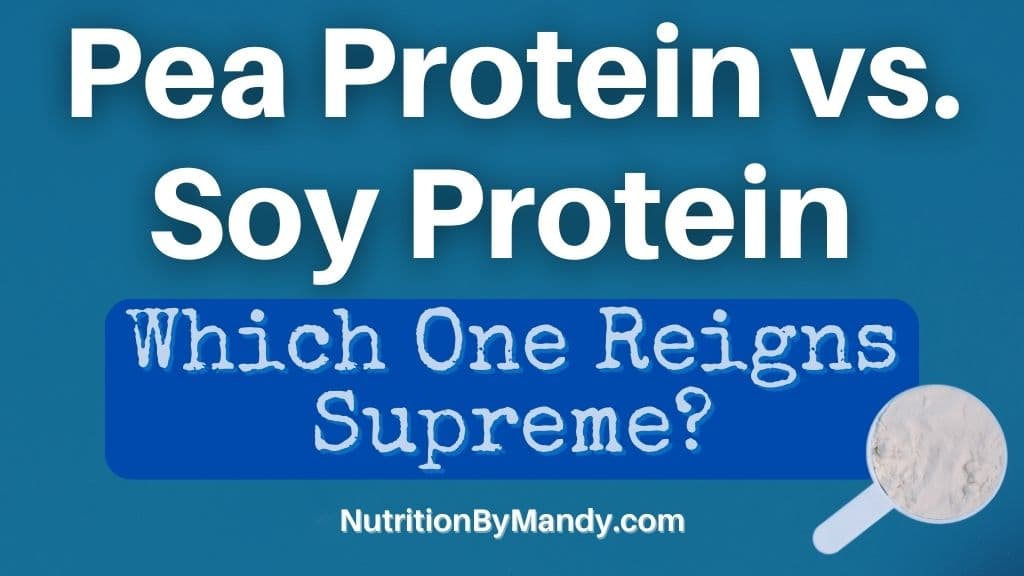Last Updated on July 18, 2023 by Mandy Tyler, M.Ed., RD, CSSD, LD
Pea Protein vs. Soy Protein: Which One Reigns Supreme?
This blog post was written by dietetic intern Natalie Larsen. Reviewed and edited by Mandy Tyler, M.Ed., RD, CSSD, LD, LAT.
Plant-based protein options have become increasingly popular amongst athletes in recent years. Pea protein and soy protein are two common plant-based options available for athletes to use to meet their protein needs.
Let’s discuss the importance of protein in the diet of athletes. Then we will compare and contrast pea protein vs. soy protein to help athletes understand the similarities and differences between the two proteins.
Protein Needs of Athletes
Protein is an essential nutrient with many important roles in the body. Including adequate amounts of protein in an athlete’s meal plan is necessary to support muscle growth and repair. Protein is also needed to transport oxygen in the body, help maintain fluid balance, and support immune health (1).
Protein recommendations for athletes are typically based upon body weight. In order to get the most benefit from protein intake, athletes are encouraged to spread their protein intake throughout the day with meals and snack (2).
In regard to amount, athletes should aim to eat ~0.25 grams of protein per kg of body weight at each eating occasion (2). For most athletes this calculates to be approximately 25-30 grams of protein with each meal.

Amino Acids: Building Blocks of Proteins
Protein is composed of 20 individual amino acids, or building blocks, that the body uses to build and repair muscles. Of the 20 amino acids, 9 are considered essential. The body cannot make the 9 essential amino acids; thus, they must be consumed in the diet (2).
When comparing proteins, it is common to look at the amino acid profile to determine the amount of each essential amino acid the protein contains. Proteins containing sufficient quantities of all of the essential amino acids are considered high-quality, complete proteins (2).
Pea Protein vs. Soy Protein Overview
Let’s now look at the similarities and differences between pea protein and soy protein to help athletes determine which protein will best meets their needs.
Pea Protein: Nutrient Content
Pea protein is derived from field peas, most commonly a yellow split pea variety (3, 4). The peas are typically processed to remove the outer skin and then ground into a fine powder, which is further processed to extract the protein. The result is a plant-based protein known as pea protein isolate (5).
Pea protein contains all of the essential amino acids. However, it contains a relatively low content of the essential amino acid methionine. Compared to soy protein, pea protein has a higher concentration of the amino acids, lysine and leucine (3, 4, 6).
An additional benefit of pea protein powder is that it contains the mineral iron. Iron is important for the transportation of oxygen in the body, supporting healthy connective tissue, and for growth and development (7).

Soy Protein: Nutrient Content
Soy protein is a plant-based protein derived from soybeans. It is commonly used as a dietary source of plant-based protein. Soy protein is valued for its nutritional profile and versatility in various food products (8).
Similar to pea protein, soy protein contains all of the essential amino acids. Soy protein is also low in the essential amino acid methionine (3, 6, 9).
Soy protein is known for its isoflavone content. Isoflavones are plant-based compounds associated with many health benefits in the body. For example, the consumption of isoflavones from soy protein has been shown to improve blood cholesterol levels, reduced risks of cardiovascular disease, and have protective effects for bone health (10, 11, 12).
Despite the benefits associated with soy consumption, many individuals have concerns and questions regarding whether or not soy is safe to consume. For a deeper dive into common misconceptions regarding soy protein, check out the article: Pros and Cons of Soy: Should You Be Concerned, by Marian Tointon, Registered Dietitian Nutritionist.

Pea Protein vs. Soy Protein: Nutrition Facts Comparison
Below is the nutrient content comparison of 100 grams of pea protein isolate vs. 100 grams of soy protein isolate (NOW brand protein powders, 13, 14).
| Pea Protein | Soy Protein | |
| Serving Size | 100 grams | 100 grams |
| Calories | 364 | 375 |
| Carbohydrates | 3 | 0 |
| Protein | 73 | 83 |
| Fat | 6 | 2 |
| Sodium | 970 mg | 708 mg |
| Iron | 24 mg | 12.5 mg |
Pea Protein vs. Soy Protein: Taste, Texture, and Versatility
Taste, Texture, and Versatility bf Pea Protein
Pea protein has a mild, bland flavor, which makes it versatile to use in various recipes and food products. Since it does not have a strong taste, it blends well with other ingredients and flavors (15).
The texture of pea protein is typically fine and smooth, making it easy to mix into liquids without clumping. When used in recipes, it can contribute to a smooth and creamy texture (15).
Pea protein is often used in the development of plant-based meat alternatives and vegan products (4). For example, pea protein can be found in veggie burgers, meatless sausages, plant-based deli slices, and other meat substitute products.
Taste, Texture, and Versatility of Soy Protein
Soy protein has a mild or slightly nutty taste, depending on the brand. On its own, soy protein isolate can have a relatively neutral flavor, making it versatile for use in various applications. However, some detect a “beany” taste, especially in less refined soy protein products.
Soy protein isolate, generally has a fine and powdery texture. It dissolves easily in liquids, making it convenient for mixing into beverages and recipes. Soy protein concentrate, however, typically has a texture that is slightly coarser. Similar to flavor, the texture also varies depending on the brand.
Soy protein is commonly used in plant-based dairy alternatives such as soy milk, yogurt, and cheese. Soy protein can also be baked into protein bars and muffins and used in meat substitutes.
Pea Protein vs. Soy Protein: Digestibility
Plant-based sources of protein from whole foods are generally not digested and absorbed as efficiently as animal-based protein sources. However, the lower digestibility of plant-based sources of protein is largely related to the presences of anti-nutritional factors, such as insoluble fiber, in whole plant foods (16, 17).
When plant-based sources of protein are processed to extract the protein and form isolates, such as pea protein isolate or soy protein isolate, the digestibility is often similar to animal-based protein sources (17).
Pea Protein vs. Soy Protein: Allergens
Allergen Considerations for Pea Protein
Pea protein is not recognized as a common allergen and is generally well-tolerated by most individuals (3). However, it is important to note that individuals can have an allergy to pea protein. In addition, it is possible that as pea protein becomes more widely available in the marketplace and used in products, an increase in pea protein allergies may be seen (18).
Peas are a type of legume, as are both peanuts and soybeans. Thus, individuals with a peanut allergy may also be susceptible to allergies with other types of legumes.
However, how a person responds to different allergens is highly individualized. Athletes with an allergy to either peanuts or soybeans should visit with their physician or allergist regarding the use of pea protein in their diet (19).
It is also worth noting that some commonly available pea protein products may be produced in facilities that process common allergens, thus cross-contact with other allergens may occur.
Allergen Considerations for Soy Protein
Soy protein is derived from soybeans. Soybeans are identified as one of the nine major food allergens in the United States.
Individuals with a soy allergy may experience adverse reactions when consuming soy protein or soy-based products such as (20).
- Hives
- Swelling in the face, mouth, or throat
- Difficulty breathing
- Abdominal pain
- Nausea
- Vomiting
- Diarrhea
It is advised that athletes with a soy allergy or intolerance avoid soy protein and items containing soy to prevent a potential adverse reaction (20).
Pea Protein vs. Soy Protein: Sustainability
Sustainability of Pea Protein
Pea protein production generally has a lower environmental impact compared to soybeans and animal-based protein sources. Peas typically require fewer resources to grow and harvest, such as less water and fertilizer (4, 21).
Peas grow well in a variety of climates and can withstand low temperatures during cold seasons. In addition, the cost of producing pea protein is relatively low, making it one of the most important legume crops globally (3, 4, 21).
Overall, pea protein is a sustainable, environmentally-friendly plant-based protein option. However, it is important to note that sustainability can vary depending on the specific agricultural practices utilized, processing methods, and transportation involved.
Sustainability of Soy Protein
The sustainability of soy protein also varies based upon a variety of factors, including: agricultural practices, land use, deforestation, and processing methods.
Historically, one of the main sustainability concerns with soy protein is the potential for deforestation and habitat loss. This has been a particular concern in South America, in areas such as Brazil, where soybeans are grown on land that was previously covered by forests (22, 23).
The growth of soybeans in the United States, however, has not resulted in concerns related to deforestation (23). In addition, anti-deforestation policies in Brazil are helping to reduce the environmental concerns related to the clearing of forest land (22).
Soybeans are less water-efficient and require more water to cultivate than field peas (21, 24). However, it should be noted that water management practices and agricultural methods for growing and harvesting soybeans vary amongst farmers and regions.
Protein Powder Safety Considerations
Regardless of the type of protein powder an athlete is considering for use; it is important to keep safety in mind. Supplements are not regulated by the Food and Drug Administration in the same way that food is. Dietary supplements may contain banned substances that could potentially make you ineligible for competition.
Due to this, it is important for athletes to look for supplements that have been third-party tested. Supplements that are third-party tested have an outside organization evaluate the supplement for accuracy of ingredients. Two companies that evaluate sports supplements are NSF International Certified for Sport and Informed Sport.
There are third-party tested supplement options for both pea protein and soy protein. Also keep in mind that although protein powders may be a convenient option when time is limited, they should not replace real food in the diet. There are plenty of ways that athletes can add protein to a shake with food sources that provide additional nutrients aside from just protein.

Pea Protein vs. Soy Protein: How to Determine Which Protein is Best for You
Pea protein and soy protein are both plant-based protein options that can be incorporated into an athlete’s meal plan. The two types of protein contain very similar nutrition profiles, have a mild taste and smooth texture, and are available in a variety of flavors.
When choosing between the two types of protein, athletes should consider individual preferences as well as food allergies. If athletes have no special dietary restrictions, either option can support the athlete with meeting their protein needs.
When considering the use of a protein powder, or any sport supplement, it is always best to consult with a sports dietitian nutritionist. The sports dietitian nutritionist can work with you on evaluating the safety and quality of supplements you are considering.
For additional sports nutrition tips for plant-based athletes, check out my blog: Gaining Weight on Vegan Diet Plans.
Join the Nutrition By Mandy Email List & Get a Free Athlete’s Grocery List
Click HERE to join the Nutrition By Mandy e-mail list. When you join you will receive a free athlete’s grocery list to print and take with you to the store.
About Mandy
Mandy is a Sports Dietitian Nutritionist in the San Antonio, TX area. She is a Registered and Licensed Dietitian, a Board-Certified Specialist in Sports Dietetics, a Licensed Athletic Trainer, and is a Certified Exercise Physiologist through the American College of Sports Medicine. Mandy has experience working with athletes at the high school, collegiate, and professional levels. She believes the key to reaching one’s full potential, both in everyday life and in sports performance, relies on a healthy nutritional foundation. Learn more about the work Mandy does here.





